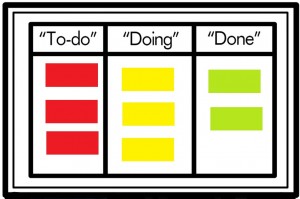Kanban
At the time of writing the UK is currently in lockdown and planning and coordinating your team’s work is becoming more and more difficult. There are many online tools to help, but where to start? And when you’ve chosen one, how do you use it effectively?
Over the next three blogs, we’ll be looking at this very subject. We start by covering exactly what the ‘Kanban’ method is.
Kanban is a Japanese term that means “Signboard” or “Billboard”

The first Kanban system was developed for Toyota by Taiichi Ohno, an Industrial Engineer. It started as a simple planning system to control and manage work and inventory in manufacturing. It drastically increased productivity, efficiency and productivity and became widely adopted.
Kanban relates to ‘Lean’ and ‘Just in Time’ production. Lean production cuts out waste, whilst ensuring quality and can be applied to all parts of a business; from design, right through to distribution. Costs are cut and the business becomes more efficient and responsive.
Kanban as applied to IT, Software development and knowledge work evolved from a 2004 project at Microsoft. (This process is described in the book “Kanban: Successful Evolutionary Change for Your Technology Business” by David J Anderson.) In these areas, the aim is to provide a visual process management system. This will hopefully aid decision-making about what should be done, when it should be done, and, crucially, how much should be done.
Kanban Boards
A Kanban board is a tool that can be used to implement Kanban for managing work.
On a Kanban board, work is shown at various stages in a process.
- Cards are used to represent work items
- Columns represent stages of the process.
Cards are moved from left to right to show progress. if required, a Kanban board may be also be divided into horizontal “swim lanes” representing different kinds of work or different teams involved.
In the simplest Kanban board model, there are three columns, as shown in the illustration above:
- “To Do”: Tasks that are not yet started.
- “Doing”: Tasks that are in progress.
- “Done”: Tasks that are completed.
However, as you might expect Kanban is not quite as simple as creating a board and putting cards onto it. Please come back for our next blog about how the Kanban Method actually works.
0 Responses to “What is Kanban?”
Leave a Reply